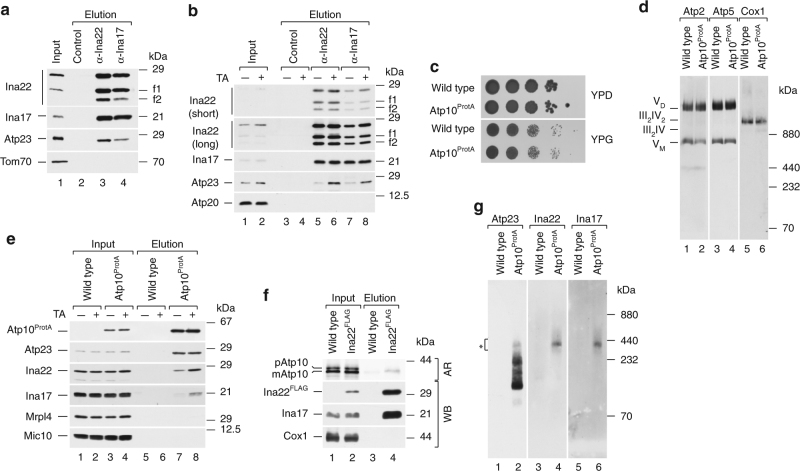Fig. 3.
The INA complex associates with Atp23 and Atp10. a Proteins from wild-type mitochondria were co-immunoprecipitated with control, anti-Ina22, or anti-Ina17 antibodies. Input and elution fractions were analyzed by SDS-PAGE and western blotting with indicated antibodies. Input = 1% of elution. f1, f2–Ina22 fragments. b Proteins from control and chloramphenicol-pretreated wild-type mitochondria were co-immunoprecipitated with control, anti-Ina22, and anti-Ina17 antibodies and analyzed as in a. Input = 1% of elution. TA translational activation. f1, f2–Ina22 fragments. c Serial dilutions of yeast cells were spotted on YPD or YPG medium. Plates were grown at 37 °C for 5 days. d Mitochondria isolated from wild type and Atp10ProtA yeast strains were analyzed by BN-PAGE and western blotting with indicated antibodies. e Control and chloramphenicol-pretreated wild type and Atp10ProtA mitochondria were subjected to IgG-affinity chromatography and analyzed as in a. Input = 1% of elution. TA translational activation. f [35S]-labeled Atp10 precursor (p) was imported into wild type or Ina22FLAG mitochondria. Mitochondria were solubilized and subjected to anti-Flag affinity purification. Fractions were analyzed by SDS-PAGE and digital autoradiography (AR, upper panel) or western blotting (WB) with indicated antibodies. Input = 1% of elution. mAtp10, mature Atp10. g Protein complexes from Atp10ProtA and wild-type mitochondria were purified via IgG-affinity chromatography, eluted natively via TEV-cleavage, and analyzed by BN-PAGE and western blotting with the indicated antibodies. Chloramphenicol-pretreated mitochondria were used. A star (*) indicates Atp10/Atp23/INAC-containing protein complex

